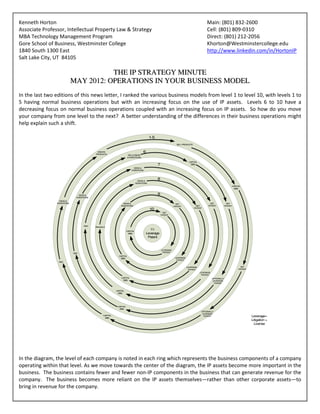
Q3 2012 IP Strategy Newsletter
- 1. Kenneth Horton Main: (801) 832-2600 Associate Professor, Intellectual Property Law & Strategy Cell: (801) 809-0310 MBA Technology Management Program Direct: (801) 212-2056 Gore School of Business, Westminster College Khorton@Westminstercollege.edu 1840 South 1300 East http://www.linkedin.com/in/HortonIP Salt Lake City, UT 84105 THE IP STRATEGY MINUTE MAY 2012: OPERATIONS IN YOUR BUSINESS MODEL In the last two editions of this news letter, I ranked the various business models from level 1 to level 10, with levels 1 to 5 having normal business operations but with an increasing focus on the use of IP assets. Levels 6 to 10 have a decreasing focus on normal business operations coupled with an increasing focus on IP assets. So how do you move your company from one level to the next? A better understanding of the differences in their business operations might help explain such a shift. 1-5 SELL PRODUCTS CREATE 6 PRODUCTS SELLS IDEAS & INVENTIONS CAPITAL 7 ($$$) IDEAS & INVENTIONS IDEAS & 8 INVENTIONS CAPITAL ($$$) IDEAS & 9 INVENTIONS IDEAS & INVENTIONS IDEAS & GET GET GET INVENTIONS PATENT GET PATENT PATENT PATENT 10 GET PATENT R&D Brainstorm CAPITAL 11: ($$$) Leverage Patent LEVERAGE R&D PATENT CAPITAL ($$$) LEVERAGE PATENT R&D LEVERAGE GET PATENT PATENT LEVERAGE PATENT CAPITAL OPTIONALLY ($$$) LEVERAGE PATENT CAPITAL ($$$) CAPITAL ($$$) OPTIONALLY LEVERAGE CAPITAL ($$$) PATENT Leverage= Litigation + License In the diagram, the level of each company is noted in each ring which represents the business components of a company operating within that level. As we move towards the center of the diagram, the IP assets become more important in the business. The business contains fewer and fewer non-IP components in the business that can generate revenue for the company. The business becomes more reliant on the IP assets themselves—rather than other corporate assets—to bring in revenue for the company.
- 2. At level 6 (transitory), the company has partially or completely eliminated the business component of creating and selling a “physical” product. The business generates revenue from existing IP assets and so has partially turned away from generating revenue using these physical products. Instead, the company creates ideas and inventions from R&D and then sells those ideas/inventions instead of—or as well as—the physical products. At level 7 (technocracy), the company decides also to strategically create new IP assets for the purpose of revenue generation. Some of the typical business operations that would normally generate revenue from other (non-IP) assets are then re-assigned to creating new IP assets. There is declining interest in selling ideas/inventions not existing as IP assets. Instead, the ideas/inventions are used to create IP assets which are then used to generate revenue. At level 8 (opportunist), the company now generates a majority of its revenue from IP assets. The typical R&D operations have been completely eliminated or partially eliminated (and replaced) with quasi-R&D (i.e., brainstorming) sessions that explore “what if” scenarios for various technologies. There is an increased focus on IP asset generation. At level 9 (privateer), the company has stopped almost all business operations except for those assets used for generating IP assets. The company no longer evens attempts any R&D that level 8 companies’ arguably employ. The company can still generate ideas/inventions, but there is no concerted effort to produce them. Rather, they are an off- shoot of the remainder of the operations. At level 10 (NPE), the only business operations of the company are the acquisition and monetization of IP assets. There is no longer any development or creation of IP assets internally within the company. Completely absent is the generation of ideas/inventions. I added a new level 11 to this diagram that I have not discussed before. In level 11, the company is leveraging the only remaining assets of the company: the IP assets. A failed start-up company is a good example of a company operating in level 11. This level is really not a sustainable business model since the company only leverages existing IP assets. There is no effort to acquire any additional IP assets as other level 6-10 companies would. And since no additional IP assets will be acquired, eventually this business model will break down because eventually the existing IP assets will become obsolete.